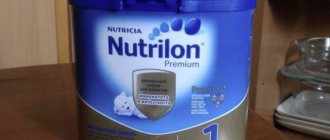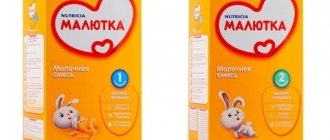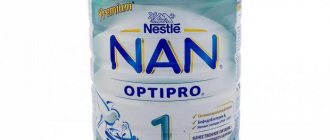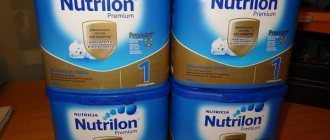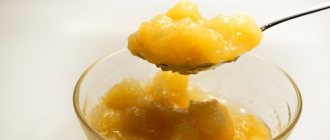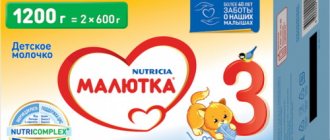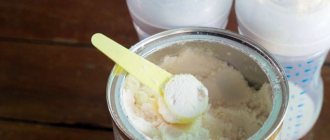There is nothing healthier for a newborn baby than mother's milk. Due to circumstances, women resort to the use of artificial nutrition. Due to illness or a simple lack of breast milk, the baby has to be transferred to dry or liquid formulas based on cow's or goat's milk. The properties of such nutrition cannot be compared with the benefits of breastfeeding. However, manufacturers are striving to bring the composition of artificial nutrition components closer to human milk. It is important for young parents to know how to dilute formula for newborns, because the proportional ratio of water and dry matter directly affects the health and well-being of the child.
Criteria for choosing formula
When choosing a mixture, you need to consider some nuances:
- Child's age.
Mixtures from the same manufacturer may be intended for different age categories. They are usually divided into several groups: children from 0 to 6 months, from 6 months to a year, and over 1 year. - Best before date.
Typically, the manufacturer writes the date of manufacture of the mixture on the bottom of the jar or on the lid, and indicates the period and storage conditions. If the product was stored in violation of the instructions, it is better not to purchase it. - Compound.
For most mixtures it is quite similar. Differences may be in the type of proteins and fats used.
Fermented milk infant formula "NAN 2" with bifidobacteria
Designed for children from 6 months to 1 year. The “NAN 2” mixture can be used as the main feeding or introduced as a milk supplement. The benefits of this diet are obvious: the intestinal microflora improves, the immune system is strengthened, and a kind of wall is built between intestinal infections and the baby’s body.
Important! The “NAN fermented milk 2” formula is strictly prohibited to be used in the first 6 months of a child’s life, since it is not an analogue of breast milk.
Types of nutrition from Nestlé
The first NAS mixtures were developed for healthy infants who needed artificial feeding. They contain all the substances necessary for the growth and mental development of the baby (vitamins, minerals, taurine, fish oil, iron).
The main NAS lines are widely used:
- NAN 1 Premium (from 0 to 6 months);
- NAN 2 (from six months to a year);
- NAN 3 (1-1.5 years);
- NAN 4 (from 1.5 years).
NAN 1 Premium
Dry formula, which is recommended for feeding healthy babies up to 6 months. Provides the body with vitamins and minerals that activate its protective functions and maintain normal intestinal microflora. The composition of the NAS mixture of this type is much richer than usual.
It is based on whey protein. It also contains skim milk, lecithin, and vegetable oil.
Hypoallergenic
Produced for two age groups NAS 1 (up to 6 months) and NAS 2 (from 6 months). It is also based on whey protein. It contains amino acids that reduce the risk of allergic reactions in the baby. That is, allergens are removed from the protein using special technologies and it becomes low-allergenic. Recommended for children with signs of food allergies, as well as for the prevention of constipation and intestinal colic.
This mixture is especially suitable for those who are hypersensitive to cow protein.
Hypoallergenic NAN contains vitamins, minerals, lactose, protein, taurine, carnitine. The mixture is also suitable for feeding healthy children without allergies.
Note!
It is not recommended to give this type of formula to a child unless prescribed by a specialist.
Pre-NAN
A special formula for children born prematurely and underweight. Pre-NAN contains fatty acids that are easily absorbed by the baby’s weak body and are necessary for its full development. 70% of the composition is whey protein, necessary for the normal formation of muscle tissue.
Lactose-free
Suitable for children with lactose intolerance.
It is also recommended for diarrhea of varying severity. Due to the low osmolarity of carbohydrates in the mixture, it alleviates the severity of diarrhea and promotes normal bowel function. Nucleotides help strengthen the immune system and restore tissue.
Fermented milk
Nan fermented milk mixture is recommended to be given to young children with gastrointestinal dysfunction, as well as during antibiotic therapy, which leads to disruption of the intestinal microflora. To ensure that protein is easily absorbed, it contains beneficial bacteria. They alleviate the baby’s condition with infectious intestinal diseases and dysbacteriosis. Pediatricians advise giving the mixture to infants with severe colic and constipation.
To maximize the benefits of feeding NAS milk formulas to children, they must be used correctly:
- You can only give formula that is appropriate for the child’s age. For older children, larger fractions are made, and digestion of large particles of the mixture by babies under 6 months will be difficult.
- Before feeding, you must wash your hands so that pathogenic microflora does not get into the mixture.
- The bottle must be sterilized (boil in water for 5 minutes) before each feeding. The pacifier only needs to be dipped into boiling water a few times.
- The water for preparing the mixture must be boiled, 35-40 o C. It cannot be boiled a second time.
- Pour the mixture into a special measuring spoon according to the dosage indicated on the package.
- Place the nipple and cap on the bottle and shake until there are no lumps left.
- The package with the dry mixture must be hermetically sealed to prevent excess moisture from being absorbed.
- The remaining prepared mixture after feeding should be thrown away and not reused.
How to boost the immunity of a frequently ill person? Find out effective ways.
Instructions for using Lazolvan children's cough syrup are described on the page.
Nan for infants: baby food, features and benefits, mixtures
Choosing a formula for a baby is not an easy, truly responsible task: will it suit the baby, will it be digested well, and will it turn out that the suitable formula does not fit into the family budget? The answer to these questions (except the last one) can only be found experimentally.
Many parents choose NAN baby food for infants - and realize that they made the right choice. And for the price this mixture is quite acceptable. What else is good about NAS products?
About the composition of the mixture
The best food for newborns is mother's milk. But for a number of reasons, the mother cannot always feed them, so she has to choose artificial analogues.
What’s interesting: modern medicine is quite well developed, medicines are being invented for diseases that were previously considered incurable, but scientists still cannot come up with a formula that would completely replicate the formula of breast milk.
Today, the closest product in terms of chemical properties is demineralized whey - it is the basis of any baby food for newborns.
Also, such food necessarily contains the following components:
- iodine - helps improve metabolism in the body and growth. Later, iodine in the required volume will be produced by the thyroid gland, but newborn babies need this element in their diet;
- polyunsaturated fatty acids (PUFAs) - linoleic and linolenic fatty acids (or omega-3 and omega-6) contribute to the proper development of the brain;
- taurine is an amino acid essential for the formation of the central nervous system, vision, and brain development. The child’s body begins to produce taurine only at 1.5 months;
- nucleotides are an element for the construction of DNA cells and RNA cells, important for the balanced development and growth of the baby, as well as for stabilizing the intestinal microflora and strengthening the immune system.
As for the NAN mixture for newborns, it contains: iodine - 93 mcg per 100 g, taurine - 39.4 mg per 100 g, as well as fish oil. The energy value is 519 kcal per 100 g, and this is the optimal value for baby food.
The composition of the mixture is balanced; when taking it, the baby will not have a deficiency of vitamins and microelements, and the likelihood of an allergic reaction to such food is minimal.
In addition, this product is recommended for children with problems in the digestive tract, as it restores and, thanks to lactobacilli in the composition, stabilizes intestinal function. And the protein complex helps reduce the metabolic load on the body.
It's worth finding out!
When talking about the composition of an adapted formula for baby food, one cannot fail to mention its “weaknesses” - this will allow parents to make an informed decision. This product doesn't have many shortcomings, but it does exist.
Firstly, the manufacturer does not decipher the types of vegetable oils in the mixture. It can be either sunflower, coconut or palm (the latter consist of more saturated fats, which are broken down more slowly and more difficult in the gastrointestinal tract).
Secondly, the mixtures contain soy lecithin. This product itself is not harmful, the only question is what kind of raw material is used - natural soybeans or genetically modified ones. Although if you ask anyone you meet why he is against GMOs, rarely will anyone give a reasoned answer.
But before deciding whether these facts are disadvantages due to which the product should be abandoned, it would not be superfluous to say that the manufacturer of NAS mixtures, the Nestle Corporation, is celebrating its 150th anniversary this year. In 1867, it was founded by the Swiss pharmacist Henry Nestlé, who began production of the world's first infant formula.
Today, factories producing this particular product segment operate in Switzerland, Germany and Holland. And in these countries, the requirements for products manufactured for babies are very strict.
There are other reasons why parents refuse this product: sometimes babies get constipated on it. But this may be a temporary phenomenon - the body’s reaction to a systematically introduced new product. Later it will adapt to the composition of this particular mixture, and constipation will disappear.
The baby may simply not like the mixture - and this is not about its quality, but about the individual preferences of such a tiny, but already individual.
NAN Product Classification
In the first year of life, a child’s body grows, develops and changes rapidly. Therefore, with each new stage of a baby’s life, the composition of his diet should change. Infant formulas have a clear gradation by age:
- “NAN - nutrition for special medical purposes” (for premature babies);
- "Nestle NAN 1 Optipro" (from birth);
- "Nestle NAN 2 Optipro" (from 6 months);
- "Nestle NAN 3 Optipro" (from 12 months);
- "Nestle NAN 4 Optipro" (from 18 months).
The levels - from 1 to 4 - are indicated in large print on the cans, which eliminates the possibility of mistakes and purchasing the wrong product.
Also, in addition to the basic line of adapted infant formulas, there are special products of the National Academy of Sciences:
- Nestle NAN Hypoallergenic mixture is for babies prone to allergic reactions. It contains a minimal amount of cow's milk (lactose);
- Nestle NAN Fermented Milk formula - for babies with intestinal problems. Pediatricians do not recommend switching completely to this mixture - it replaces 1-2 feedings per day. In this case, the main food should be a mixture of the same company - this way it will be easier for the child’s body to get used to the variety in the menu;
- Nestle NAN anti-colic mixture is for babies from birth who experience discomfort due to increased gas formation.
About the features of formula feeding
If the baby is bottle-fed, even in the maternity hospital the neonatologist will tell you how to feed him correctly.
But over time, a young mother may still have doubts about whether she remembered the information correctly.
If you have any questions, you can and should contact your pediatrician: his task is to inform parents as much as possible regarding all issues regarding the care and development of the baby, and nutrition is an important component of this complex.
The mixture must be prepared immediately before use.
Preparing it in advance and leaving it to wait, for example, for returning from a walk or waking up at night is convenient, but such a mixture is not only not tasty, but also not healthy.
The maximum shelf life of the finished portion is only 2 hours. If it is not eaten, the contents of the bottle are poured out, and the container itself must be sterilized.
The transition from one formula to another (for example, from the NAN formula for newborns to the NAN 2 formula) should be carried out gradually.
First, add a new spoon to the first mixture, the next day - two spoons, on the third - three, gradually reducing the volume of the first mixture and increasing the volume of the second.
If the transition is made abruptly and completely, the child’s body may react to such a change with bloating, colic and constipation. The same applies to the introduction of special products “NAN Fermented Milk” and “NAN Anticolic” into the diet.
NAN baby formulas are products of a company with a long history, for which high quality is one of the main guidelines. By choosing it, you can be sure that your baby will receive truly balanced, high-quality nutrition.
Source: https://mirgrudnichka.ru/pitanie-i-prikorm/nan-dlya-grudnichkov.html
How to properly introduce formula into a baby's diet
The best formula to choose for a child can only be determined by a pediatrician who is well aware of his health and condition. You cannot experiment on your own and regularly change one mixture to another.
Before introducing NAN mixture into your diet, you must adhere to the following recommendations from pediatricians:
- Strictly follow the instructions for use, diluting the product with water.
- The first dose of the mixture introduced into the diet should not exceed 90 ml.
- At the same time, there is no need to give your baby other new foods that can provoke an allergic reaction.
- With a mixed diet (formula and breast milk), the mother must strictly limit the diet.
- For the first 3 days after introducing formula into the diet, you need to monitor the child’s condition (for abnormal bowel movements, rashes, colic).
If an allergy appears while consuming the mixture, it must be changed to another (as recommended by the pediatrician).
Product cost
The price of the NAN mixture is determined depending on the type of product and the components in its composition. It can vary between 400-700 rubles. The usual formula for healthy children NAN 1 will cost parents 400-500 rubles. Medicinal mixtures (hypoallergenic, fermented milk) – 600-700 rubles.
Good afternoon
When my baby turned half a year old, we were just starting to supplement the formula with only 1-2 feedings per day, so we were quite happy with the formula with number one. Moreover, at first it was Nutrilon Comfort 1, then Ordinary Nutrilon. And only on the third attempt we were lucky and through trial and error we found the right one - Nan 1.
By that time the child was already more than eight months old. At the same time, supplementary feeding with the mixture was also approximately 1-2 times a day, the rest of the time there were vegetables, cereals, cottage cheese and breast milk. When the baby was nine months old, I asked our pediatrician about the formula, because it was high time to switch to number 2! To which I received the answer that this can be done, only children endure this transition often painfully. Again, tummy problems, diarrhea, constipation, restless nights and other delights may arise.
But I decided to take a risk and move on.
Appearance…
The difference from its counterparts is minimal - the number 2 on the front side of the can.
Once again, I would like to note a convenient special “floor” for storing a measuring spoon. Many manufacturers have not thought through this point at all!
How to fill a spoon without a slide...
Compound….
In fact, there is only one NAS. Numbers 1, 2 and 3 differ in the ratio of nutrients.
I wrote it out specifically for comparison.
NAS 1 b
- 9.6
f
- 27.7
y
- 57.8 NAN 2
b
-10.82
f
-21.5
y
- 60.79 NAN 3 (hypoallergenic)
b
-14.8
f
- 22.7
y
- 57, 5. The same goes for vitamins and minerals.
All contain vitamins, bifidobacteria, optipro protein, smart lipids, amino acids and minerals.
Nan 2 contains more carbohydrates and fats because the child moves more at this age and needs additional energy.
The composition is generally good. Naturally, I am confused by the presence of palm olein. But it is found in almost all infant formulas.
Cooking...
With this, too, everything is standard: wash your hands, wash and sterilize bottles and nipples, boil water, cool it and measure it, add the mixture according to the instructions. Check the temperature of the finished mixture. All! Now you can feed.
According to the instructions, you should feed 210 ml (seven spoons of dry mixture) twice a day.
It dissolves very well in water. No lumps, no sediment, no foam! Everything is fine.
Transition from NAS 1 to NAS 2….
There is no need to switch, as pediatricians advise, from a mixture from one manufacturer to a mixture from another. You can immediately replace all feedings with another number, the manufacturer and the mixture are the same.
But I was afraid to do this, especially since I had a large 800 gram jar of one at home. I bought a small jar of two and, crossing my fingers, first gave literally 60 ml for testing, naturally, this amount is very small for one feeding, so I diluted the one additionally in another bottle.
I didn’t feel much difference either in the child’s behavior or well-being, so I boldly replaced all feedings with NAN 2.
I didn't notice any differences in taste either. Purely in appearance, NAN 2 is slightly yellower than NAN 1.
Three days later, small red rashes appeared on the child’s face. We began to reconsider our diet. They didn’t think about the mixture right away.
A day later the rash was already in the perineum and the child became restless.
I decided to feed one again. The rashes are gone.
They did not feed this mixture again.
Result: Give a positive rating to NAN 2 infant formula, I can’t raise my hand! At the moment we are eating a mixture of NAN 3 hypoallergenic (I chose it not by chance) - everything is fine. No diathesis, no problems with the stomach and stool. It's a shame that NAN 2 caused an allergic reaction.
I wish all mothers to feed their babies breast milk for at least one year! And there are no problems with infant formula! Breastfeeding is wonderful! I was not very lucky and the milk ran out earlier than I would have liked!
Thank you for your attention!
Price for 400 grams: about 500 rubles.
Baby food "NAN" is produced by the Nestle concern, which has many years of experience in producing similar products since 1867, when the company's founder, Henry Nestle, created the first prototype of a modern breast milk substitute. Since then, the concern has continued to work on improving milk formulas, using theoretical knowledge and the results of in-depth research to create products that are as close in composition as human milk and can provide nutrition to a child in the absence or impossibility of breastfeeding.
"NAS fermented milk": reviews
Most mothers willingly confirm the manufacturer’s statements regarding the beneficial effects of the “NAN” mixture on the child’s body. "NAN" is an indispensable assistant for intestinal dysbiosis, constipation, pain and colic. Separately, they note that transferring a child to artificial nutrition is not difficult; the baby quickly gets used to the pleasant taste of fermented milk.
“NAS fermented milk 1” has the most positive reviews. Many consumers emphasize its medicinal properties. The result of its use is the normalization of intestinal microflora, improved stool, strengthened immunity, and reduced risk of infectious diseases. In addition to the quality characteristics, the practicality of use was also noted: a convenient jar made of durable material, equipped with a measuring spoon, the overall characteristics of which were developed taking into account the size of the neck of a baby bottle. And the “NAN” mixture is also profitable from an economic point of view - one jar is enough for a fairly long period.
“NAN fermented milk 1”, reviews of which contain information regarding disgusting taste, poor solubility, and impossibility of use as the main feeding, do not correspond to reality! Firstly, the mixture is fermented milk, that is, it cannot be sweet in order to please all mothers. Yes, yes, you read correctly, that's right. Secondly, any pediatrician will refute the statement that “NAN” cannot be used for constant feeding. Of course, there are certain indications, contraindications, etc., but this does not mean that “NAN” cannot be given to a child all the time.
Analyzing consumer reviews, one more thing can be said: the NAN mixture is characterized by satiety. And it is not just words. This is a conclusion made after conducting amateur experiments, when women gave their baby “NAN” mixture for dinner one day, and “Malysh” on the other. The time it takes to saturate a small organism with the first mixture significantly exceeds that of the second. Therefore, many mothers prefer to give “NAN” at night so that the child is full and sleeps soundly.
We have already discussed the advantages of the dry mixture. Let's move on to the disadvantages, if any, of course. Using NAN Fermented Milk yourself, reading reviews about it, you can understand that there are no shortcomings as such. For some, it is the too high cost of food, while others decided that the child is accustomed to the formula and does not want to eat anything else. Well, you must admit, these reasons are biased.
In conclusion, I would like to say one thing: every child’s body is individual! The same mixture can cause completely opposite reactions in children. This fact was taken into account by baby food manufacturers, as a result of which on the shelves with formulas you can find a wide range of products, a mind-boggling number of varieties that contain certain additives. There is no bad Nestle baby formula, because this Swiss manufacturer is a guarantor of nutrition quality. There are simply formulas that are not suitable for your baby. This is why it is so important to choose the right baby food.
Types and composition of NAN mixtures for healthy children
Since a child’s needs for nutrients and biologically active substances are not the same at different times of his life, the Nestle concern has created a line of infant formula and baby milk NAS.
- "NAN" 1 Powdered milk formula from birth.
- “NAN” 2 Powdered milk formula from six months.
- "NAN" 3 Baby milk from twelve months.
- "NAN" 4 Baby milk from eighteen months.
The age indicated on the packaging must be observed, since the body of a young child is not yet adapted to accept the mixture intended for older children. The packaging design has undergone some changes. A transparent window has appeared on the lid, which reveals a measuring spoon, isolated from the product with foil. Now you can just take a spoon and not search for it in the mixture, thereby violating its sterility.
In addition to dry formulas, there are liquid formulas “NAN”1,2 in 200 ml packages, which are no different in composition from dry ones and the only thing you need to do before giving them to your child is pour them into a bottle and heat them up.
"NAS 3"
“Nan 3” is a fermented milk product intended for feeding healthy babies over a year old. “Nan 3” is a fully balanced fermented milk mixture. In terms of the content of nutrients, vitamins and minerals, it is an absolute analogue of cow’s milk or kefir in a child’s daily diet.
Nutrition "NAN 3 fermented milk" combines a unique combination of protective components "Protection and Growth", helping to strengthen the baby's immune system and improve digestion processes.
What is OPTIPRO bolok in NAN mixtures and why is it added there?
“NAN”1 and “NAN”2 are adapted infant formulas, and “NAN” 3 and “NAN” 4 are dry milk drinks for feeding children. The main difference between them is the reduced protein content in the adapted mixtures due to a significant amount of demineralized whey. In dairy drinks, the required protein balance is achieved through skim milk and whey protein. Thanks to this, in “NAS”1 the optimal ratio of whey proteins and casein 70:30 is close to the same ratio in breast milk of 80:20. Perhaps no other mixture can boast of the same almost ideal values. For “NAN”2, “NAN”3 and “NAN”4 the ratio of whey proteins and casein is 60:40, as for. This protein is called OPTIPRO.
It allows you to reduce the metabolic load and ensure a reduction in the risk of obesity in the future due to the correct ratio of proteins and maintaining the necessary balance of amino acids. The time-prolonged effect of nutrition in early childhood on metabolic characteristics in adulthood is now increasingly confirmed, and in this light, the OPTIPRO protein looks very convincing. Since breast milk differs in amino acid composition from cow's milk, the NAN Optipro 1 mixture contains essential amino acids, especially necessary for infants: taurine, phenylalanine and histidine.
Other composition features
The natural carbohydrate component of NAN products for healthy children is lactose, which, in combination with maltodextrin, provides a sweet taste, provides the necessary energy to the child’s body, promotes a long-lasting feeling of fullness and makes the product thicker. “NAN” 3 and “NAN” 4 do not contain sucrose, which distinguishes them favorably from some similar products from other manufacturers.
The fatty component is a mixture of oils and fish oils that provide the body with essential fatty acids. Until recently, palm olein, one of the fractions of palm oil, was used in NAN baby food. However, due to widespread “anti-advertising” of palm oil, Nestle refused to use it. Now in baby food “NAS”1,2,3,4, depending on the division by age of the baby, only sunflower, high-oleic sunflower, low-erucic rapeseed and coconut oils can be found from vegetable oils. The complex of polyunsaturated fatty acids in NAN mixtures is called “Smart Lipids”, the most important of them are docosahexaenoic (DHA) and arachidonic (ARA) acids, which help strengthen the immune system and are necessary for the proper development of vision and the brain.
Baby food "NAN" is one of the few fresh mixtures that contain probiotics - live cultures of bifidobacteria BL, which contribute to the formation of beneficial microflora of the large intestine and strengthen the immune system. The composition of “NAS”2,3,4 additionally includes lactobacilli DENTA PRO, which inhabit the entire digestive tract of a healthy person, and by populating the oral cavity, they contribute to the prevention of caries.
All NAN mixtures contain the necessary complex of vitamins and minerals that meet the age-related needs of an infant.
New packaging and new composition of the mixture “NAN”1
Children's fermented milk food "NAN 1"
Designed for feeding babies from the moment they are born. The mixture “NAN fermented milk 1” combines a unique combination of protective components “First Defense”, helping to activate the immune system, strengthen it, and improve intestinal microflora. Healthy immune microflora is supported by live probiotic cultures contained in baby food. They are also called bifidobacteria Bl. Biofermentation of the product helps improve intestinal microflora and is an insurmountable barrier to any infection on the way to the intestines of a newborn. Children's "NAS fermented milk 1" - balanced nutrition for the baby from the first days to six months, ensuring his optimal growth and development - both mental and physical.
The mixture is easily digestible. It has a pleasant sour milk taste, which is the primary reason that NAN food has been one of the most beloved infant formulas for many years, which not a single child in the world has yet refused. But not only children, but also their mothers will like this food, since it will help get rid of constipation and gas, which means it will give a couple of restful hours of sleep.
In addition, “NAN fermented milk” acts as a preventative against anemia - the composition of the mixture includes a sufficient amount of iron.
Therapeutic, prophylactic and medicinal mixtures "NAS"
These mixtures are used for a short time as prescribed by a pediatrician for the purposes of therapeutic and preventive diet therapy. In general, they are characterized by the same composition as “NAN” mixtures for healthy children, but there are also differences associated with the characteristics of their purpose.
"NAS Fermented Milk" 1,2,3
Helps normalize intestinal microflora, improves digestion, protects against intestinal infections and strengthens the immune system.
The composition of “NAN Fermented Milk” differs from the usual “NAN” due to the fermentation of the milk component under the influence of special microorganisms that cause lactic acid fermentation. This process is accompanied by the breakdown of protein, lactose and fat with the formation of numerous chemical compounds that are fundamentally new (vitamins, lactic acid, bactericidal substances) or are products of the breakdown of the original compounds (peptides, fatty acids). In fact, part of the work of the digestive enzymes of the gastrointestinal tract is taken over by the starter bacteria, making the digestion process faster and less energy-consuming. “NAN Fermented Milk” 2.3 is distinguished by an equal ratio of whey proteins and casein. All NAN Fermented Milk mixtures contain live lactic acid bacteria and bifidobacteria, which determines their probiotic properties.
"NAS Antikoliki"
The main purpose is to prevent the occurrence of colic. The mixture is intended for children from birth and is not divided by age.
The protein of the mixture is partially hydrolyzed, which facilitates the process of assimilation of the mixture and reduces the risk of allergic reactions. Low lactose content reduces fermentation processes caused by a temporary decrease in lactase activity in the first months of life, and gas formation, which are the causes in the child. The probiotic culture of lactobacilli L.reuteri supports digestion, promotes the development of beneficial intestinal microflora and is absolutely safe for a newborn.
"NAS Triple Comfort"
It is used to eliminate the symptoms of functional digestive disorders accompanied by colic, constipation, and disturbances of the intestinal microflora.
The product is intended for children from birth and is not divided by age.
It has a composition similar to NAN Antikoliki. The difference lies in the additional introduction of prebiotics (oligosaccharides), necessary for the normal development of beneficial intestinal microflora.
"NAS Hypoallergenic"1,2,3
It is used if there is a family predisposition to an allergy to cow's milk protein or as an intermediate formula when transferring a child from a therapeutic formula to a regular adapted formula.
It is one of the preventive hypoallergenic mixtures, as it contains partially hydrolyzed whey proteins, which reduces the risk of allergic reactions. The degree of protein breakdown is higher than in other NAN mixtures with hydrolyzed protein. Live bifidobacteria BL are the only culture of microorganisms in the mixture.
"NAS Antireflux"
Helps eliminate regurgitation in infants. The mixture is intended for children from birth and is not divided by age.
Due to the addition of a thickener, which is starch, it forms a dense clot in the stomach, which prevents regurgitation and provides a long-lasting feeling of fullness. At the same time, starch has a fixing effect, so if you are prone to constipation, this mixture is not suitable for a child. The protein of the mixture is moderately hydrolyzed, easily digestible and reduces the likelihood of allergic reactions. The probiotic culture of lactobacilli L.reuteri, similar to that found in breast milk, helps reduce regurgitation by three times, normalizes the microflora and has a beneficial effect on the baby’s digestion.
"NAN Lactose Free"
Designed for children with lactase deficiency, it helps the child’s body recover after suffering from diarrhea. The mixture is intended for children from birth and is not divided by age.
The mixture is not hypoallergenic, the ratio of whey proteins and casein is 60/40, and differs from “NAN”1 by an increased proportion of casein. Lactose has been replaced with glucose syrup, which is much easier to digest. Probiotics are represented by lactobacilli L.reuteri.
"Pre NAN" for premature babies
Designed for feeding premature and low birth weight babies. Provides the child with all the necessary substances for rapid growth.
The ratio of whey proteins and casein is 70/30. The protein of the mixture is partially hydrolyzed, which has a beneficial effect on the rate of its absorption and reduces the risk of allergies. An optimal balance of calcium and phosphorus contributes to the proper formation of bone tissue. The mixture is used until the child reaches a body weight of 1800 g, since it contains a fairly high protein content of 2.2 g/100 ml of the mixture, after which Pre NAN is replaced with a regular adapted mixture. In addition to the dry mixture, there is also a liquid ready-to-use mixture “Pre NAN”0 (PreNAN).
Breast milk fortifier "Pre NAN FM85"
For special medical purposes for low birth weight and premature babies to enrich breast milk.
“PreNAN FM 85” helps to enrich breast milk with essential nutrients, the amount of which, despite the unique composition of the milk of mothers who gave birth prematurely, is still scarce. Also, a breast milk fortifier (fortifier) allows you to increase the amount of nutrition the baby receives if breast milk is not enough. Pre NAN FM85 can be used according to the general dilution scheme or after analyzing a woman’s breast milk, taking into account individual characteristics. The use of this diet requires mandatory medical supervision.
How to properly feed a newborn with Nan 1 formula
The best nutrition for a newborn baby is breast milk, but not every mother can provide it to them. In this case, introducing formula milk helps.
In their composition, they are as close as possible to mother's milk.
Which NAN to choose
For babies who have just been born, NAN 1 Premium is recommended from birth. It can be given to babies if the mother has lost milk for some reason.
It is important to introduce food gradually so that the child can absorb it and get used to it. The pediatrician will advise how to do this. Then the baby will grow and develop normally.
The composition of NAS infant formula for newborns includes:
- whey demineralized;
The composition contains L-carnitine, as well as L-arginine, L-histidine.
In order for the baby to develop harmoniously, sulfates of copper, iron, manganese, and zinc are introduced into it.
You can learn about the signs of the disease and what thrush in a newborn’s mouth looks like in this article.
Signs of rotavirus infection are described in this article. Here we talk about the treatment and prevention of the disease.
Types, composition and differences, average prices
To understand which of the NAN 1 infant formulas is best for a newborn, you need to study all types of NAN infant formula.
The mixture is hypoallergenic. It is prescribed from birth. The protein contained in the product has reduced allergenicity, which minimizes the risk of colic and constipation.
Indicated for children with minor manifestations of food allergies, prescribed for its prevention. Suitable for children suffering from cow protein intolerance.
Fermented milk mixture NAN for newborns, enriched with bifidobacteria. It is prescribed to children taking antibiotics and those who have gastrointestinal disorders.
It contains optimized protein OPTI PRO1, bifidobacteria Bl.
NAN lactose-free - suitable for lactose intolerant infants suffering from mild to moderate diarrhea.
This product contains maltodextrin, which reduces diarrhea, and nucleotides, which strengthen the immune system.
Pre-NAN - prescribed to premature babies with low body weight. Contains easily digestible fatty acids necessary for vision, normalization of central nervous system functions, mental and psychomotor development.
The increased content of whey proteins helps in the absorption of baby food.
ALFARE - indicated for children suffering from chronic, acute diarrhea. It can only be used under the supervision of a pediatrician.
It is characterized by an optimal content of amino acids, good taste, contains lipids that relieve inflammation, vitamins and minerals.
NAN Antireflux - given to children who regurgitate heavily from birth. Only a pediatrician can prescribe such a mixture.
You can purchase NAN in regular stores and pharmacies. Prices depend on the type of product.
NAN 1 Premium will cost the least: you will need to pay 470-500 rubles for a box.
Recommendations for selection
When choosing food for a newborn, you need to consider:
The expiration date can be seen on the lid or bottom of the jar. There is also information about storage rules. If the product was stored in unsuitable conditions, it is better not to buy it.
The composition of the mixtures is largely similar; there are certain differences in lactose-free and fermented milk products.
If you want to know what catarrhal otitis in children is, read this article.
What is scarlet fever disease? How does it occur in children? You will find answers to your questions in this article.
What is the incubation period for rubella in children? Our publication will tell you about this.
How to breed artificial milk
You can only use baby food that has a shelf life of more than a month. If it expires after a few weeks, it's best to throw the jar away.
A newborn baby has a sterile intestine. To prevent the baby from getting sick, when diluting the powder, you must carefully follow the basic rules of hygiene.
To find out how to properly dilute NAN formula for newborns, carefully read the instructions on the package. Wash your hands with soap and take out a pre-prepared sterile bottle.
Determine the required ratio of powder and water, taking into account the baby’s age, pour water into the bottle, and add the powder.
Close the bottle and shake thoroughly until the powder dissolves well. Make sure there are no lumps left.
You must follow the instructions exactly. Some mothers strive to feed their children better, so they dilute the powder thicker than required.
Prepare food for one time, do not store it in the refrigerator. If there is anything left in the bottle, pour it out.
Dangerous microorganisms multiply quickly in the finished product, so it’s not worth risking the baby’s health.
Suitable water and temperature
Pediatricians recommend diluting baby food with special water, which is sold in baby stores.
It is produced by many well-known companies. Boiled water contains dangerous impurities, so it is not advisable to use it.
Special water for children has many advantages:
- passing strict quality and safety controls;
optimal content of microelements and oxygen.
The packaging contains information about what kind of water is suitable for diluting the mixture: it should not be hotter than 36-37 ° C. These settings are optimal.
Mother's milk has exactly this temperature.
If the water is hotter, bifidobacteria will die.
You can buy a baby food thermometer to accurately calculate the temperature.
Let's talk about compatibility
Many mothers would like to know whether it is acceptable to give their newborn two different formulas at the same time. Pediatricians do not prohibit this.
For mild lactose intolerance, pediatricians advise feeding the child a low-lactose and highly adapted formula.
This will allow the baby to receive all the necessary microelements and vitamins.
If you want to know how and how to treat whooping cough in children, read our article.
Read about what antibiotics are prescribed for pharyngitis in children in this article.
You can learn about bacterial conjunctivitis in children from this publication.
Possible reaction of the child, norms and deviations
Any product can cause a negative reaction in a baby, and formula is no exception. Therefore, introduce it gradually.
On the first day, it is advisable to give the newborn only one scoop of the mixture during feeding, and then gradually increase the amount.
You will most likely immediately understand that there is a deviation from the norm if the following signs appear:
rumbling in the stomach, gas, colic - the baby will start crying during feeding or immediately after it ends;
the appearance of a rash on the skin;
poor weight and height gain;
severe regurgitation after eating.
If they persist, then the food will need to be replaced. Before doing this, you can consult your pediatrician.
For example, if the usual formula is not suitable for you, he may recommend fermented milk nutrition for your baby.
How to tell if the food is right
Monitor your newborn's reaction carefully if you give NAN. Then you yourself will be able to understand whether she suits him or not.
There are certain signs that you can give your baby this baby food on a regular basis.
If the child sleeps peacefully, has a good appetite, and gains weight, then everything is fine.
Regular and uniform stools and good skin condition also indicate that the baby is receiving adequate nutrition.
If you do not observe at least one of the listed indicators, consult your pediatrician. You may need to choose a different diet.
Reviews from parents
We offer several reviews of NAN formula for newborns.
Then the newborn will grow quickly and develop harmoniously, delighting the parents.
2016 - no palm oil. If the mixture is suitable, do not change it. + infant formula feeding schedule
We were given Nan Opti Pro 1 mixture as supplementary food back in the maternity hospital. The hospital buys it because it suits 80% of children (in rare cases, you can try hypoallergenic NAN).
I should grow up at home and be happy, but no. The parents came up with the idea that the child was getting tired of the same mixture. And the menu needs to be diversified. Friso, Hipp, Semilak, Nistozhen, Nutrilon….
This is where the problems began: green stools, constipation - from a sudden change in diet. These brands themselves are not bad. But every child is individual. As a result, we returned to NAS and never left it again.
The child is completely artificially raised by her.
+ She was not obese. The child corresponded to the table height/weight proportions
+ Instantly soluble, but small, insignificant grains remain on the walls of the bottle
+ Taste. I don't know how to describe it more precisely. It doesn't have that cloying sweet taste like other mixtures.
+ The manufacturer makes it better and better every year. The composition is different from what it was 10 years ago. Now it has been produced without palm oil for a long time.
- Expensive. Without hot water, one large 800 g jar was enough for four days. And this is 805 rubles, that is, 6,000 per month for food for a child. (For Kostroma residents - it’s cheaper to buy in Karusel and Lenta)
- If you introduce it sharply, constipation begins. In this case, we took a jar of NAN Fermented Milk. The stool returned to normal. The NAS has probiotics (soil for the reproduction of beneficial microorganisms) and bifidobacteria themselves. And also, to normalize stool, I added a little more water, about 10-15 ml extra.
The opened mixture is not stored for a long time, so if NAN is rarely needed, it is better to buy a small 400 g jar. If you use it frequently, it is more profitable to take a larger one.
How often should I feed my baby formula, after how many hours? The answers to these questions were suggested to me by a nurse at the maternity hospital. Now there are two methods. On demand and by hour. Or a combination of them, when at first they adhere to the schedule, and then the child gets used to it and begins to demand food on an hourly basis.
Artificial newborns are given the mixture every 3 hours (8 times a day, at 6:00, 9:00, 12:00, 15:00, 18:00, 21.00, 0:00, 3:00) approximately according to the following scheme:
1 day servings of 10 grams (or ml)
Day 7 - 70 gradually remove one night feeding at 3:00 so that the child gets used to sleeping at night
Day 9 - 90 is increased to six feedings per day (6:00, 9:00, 12:00, 15:00, 18:00, 21:00)
After 14 days (3-4 weeks), give 120 grams of diluted mixture per feeding. Reduce the number of feedings to five per day (once every 4.5 hours: at 6:00, 10:30, 15:00, 19:30, 0:00)
Whatever mixture you have, if it fits well, there is no need to experiment and select others without special reasons. Grow up healthy!
PS After eating, do not forget to hold the baby strictly vertically, tilting it slightly onto his tummy so that he burps, releasing the air. Otherwise, the whole lunch will be outside)
Rate the review and more people will see it
Source: https://rody-beremennost.ru/pitanie/kak-pravilno-kormit-novorozhdennogo-smesyu-nan-1
Pros and cons of dry adapted mixture "NAN"
Any formula is not an ideal food for feeding a newborn and always has its positive and negative sides. Feeding a child, even what seems, from the mother’s point of view, to be a good formula, recommended by numerous reviews, is always associated with the risk of individual reactions in the form of colic, constipation, and allergies. The NAN mixture can rightfully be considered one of the best mixtures on the market. If the price doesn’t bother you (about 650 rubles for 400 g), you can safely trust Nestle’s rich experience and choose this mixture.
pros
- This is the only formula for children from birth “NAN”1 with a unique protein composition that is as close as possible in the ratio of whey proteins and casein to breast milk protein.
- There is no palm oil in NAN1,2,3,4 mixtures.
- The mixture contains essential polyunsaturated fatty acids, nucleotides, probiotics, essential amino acids, vitamins and minerals.
Minuses
- The lactose content is slightly higher than in breast milk, which can have a negative effect on digestion in case of lactase deficiency.
- The osmolality of the formula is higher compared to breast milk, which puts an increased load on the baby’s excretory system.
- There are no prebiotics.
There are times when it is impossible to fix. In such situations, baby milk will come to the rescue. One of the popular ones is the “Nan” mixture, instructions for use of which we will consider in this article.
Artificial feeding: the best choice or an absolute necessity
There is nothing better for a baby than mother's breast milk. It is an ideal food for babies.
Mother's milk contains all the vital and necessary components, substances and vitamins. Well, it’s so inherent in nature that a mother gives all the best to her baby from the cradle. However, there are cases when natural feeding is not possible for one reason or another.
Important! Before deciding to transfer your baby to artificial feeding, you should definitely contact your pediatrician and consult.
Description, composition and manufacturer
Brand - NAN, brand country - Switzerland, manufacturer - Nestle, country of origin - the Netherlands. "Nan 1 Optipro" is a dry adapted product containing bifidobacteria. She is created to feed from birth. A balanced composition ensures that the baby receives all the necessary nutrients that are important for physical and mental health.
The unique Optipro complex helps the baby get the required amount of protein, and thanks to living bifidobacteria BL, his immunity is strengthened. The composition contains the required amount of vitamins, minerals and trace elements. These products are made from high quality raw materials. It does not contain flavors, GMOs, dyes or preservatives. The mixture in question has a pleasant taste, and the baby will definitely like it.
Did you know?
The Nestle company began its work in 1866. And in 1867, thanks to Arnie Nestle, a product for artificial feeding of babies appeared, which was called “Arnie Nestle's Milk Flour”.
- demineralized whey;
- skimmed milk;
- a combination of vegetable oils (palm olein, low erucic rapeseed oil, coconut oil, sunflower oil, Mortierella Alpina oil);
- lactose;
- calcium citrate;
- maltodextrin;
- fish fat;
- acidity regulators (potassium hydroxide, citric acid, calcium hydroxide);
- magnesium chloride;
- potassium chloride;
- soy lecithin;
- potassium citrate;
- L-phenylalanine;
- vitamins (C, E, PP, pantothenic acid, A, B1, B6, B2, folic acid, D3, K1, B12, biotin);
- sodium chloride;
- sodium phosphate;
- taurine;
- ferrous sulfate;
- L-histidine;
- inositol;
- bifidobacteria (not less than 106 CFU/g);
- zinc sulfate;
- nucleotides;
- L-cartinin;
- copper sulfate;
- potassium iodide;
- sodium selenate;
- manganese sulfate.
Baby food "NAS": general description
"NAN fermented milk" is intended for artificial feeding of babies who do not have congenital defects, but whose breastfeeding is impossible for one reason or another. Cases that involve complete cessation of breastfeeding are described above.
Fermented milk powder "NAN" belongs to the adapted mixtures. Obtained as a result of biological fermentation provided by lactic acid bacteria. It is through this process that protein digestion and absorption are improved. All vitamins and minerals are contained in NAN fermented milk. The composition of the mixture includes: demineralized whey, vegetable oil, natural gluten-free starch, skim milk, potassium caseinate, maltodextrim, calcium citrate, potassium chloride, potassium citrate, soy lecithin, sodium chloride, magnesium carbonate, magnesium chloride, vitamins, taurine, iron sulfate, copper sulfate, potassium iodide, cultural bifidobacteria.
Baby food "NAS" is produced in the traditional way, without adding flavors, dyes and preservatives and genetically modified objects. Country of manufacture: Switzerland.
How to prepare the mixture
Let's look at how to dilute the Nan mixture:
- First, you should wash your hands well.
- The bottle, nipple and cap must be washed thoroughly.
- Then it is recommended to boil them for 5 minutes.
- Drinking water should be boiled for 5 minutes and cooled to a temperature of +37 °C.
- Following the feeding table, you should pour the required amount of water into the bottle.
- Following the table, you need to add the exact number of measuring spoons of powder that corresponds to the baby’s age. You only need to use the measuring spoon that is in the jar, filling it without a slide.
- Then shake the bottle until the powder is completely dissolved.
- It is recommended to place the spoon on the ledge in the jar.
- The jar of powder must be tightly closed.
Important!
If you use unboiled water and unsterilized bottles, store the formula incorrectly, transport and prepare it, then all this can adversely affect the baby’s health.
Cooking instructions
It is very important to properly prepare the NAN Fermented Milk infant formula. Instructions are provided on the outside of the food jar. The process of preparing fermented milk mixture “NAN” should begin immediately before feeding.
Conventionally, it can be divided into three stages:
Stage 1. Preparatory.
- Wash the bottle.
- Sterilize the bottle and nipple.
- Open the jar with the mixture. Here we immediately draw your attention to the fact that the fermented milk mixture “NAN” does not look like other mixtures - it is not crumbly. The mass is characterized by some compactness. Therefore, you should not be afraid of its appearance and accuse a store or supermarket of selling low-quality or expired products.
Stage 2. Main.
- Pick up a jar of food and study in detail the recommended feeding table, which is depicted on it.
- Pour ½ part of the water from the volume recommended in the table into the feeding vessel (sterilized bottle). The water should be boiled and cooled to 37 degrees.
- Pour in the required amount (determined depending on the volume of liquid poured and indicated in the same table on the jar) measuring spoons of the dry mixture.
- Shake the vessel until the dry mixture is completely dissolved and turns into a homogeneous mass.
- Add the remaining ½ of the liquid to the bottle.
- Shake again until a homogeneous mixture is formed. The mixture turns out to be quite thick, so you should not sound the alarm if you expected to see a liquid mass. And one more thing: after cooking, grains remain on the wall surface of the bottle, this is also the norm!
Important! You can only give your baby freshly prepared formula. It is strictly forbidden to use the one left over from previous feeding sessions.
It is very important to maintain dosage accuracy. Otherwise, lumps will form in the mixture, which will prevent it from flowing through the nipple into the baby’s mouth. Next we’ll talk about how to give “NAN fermented milk”.
Period and storage conditions of packaging
After opening the jar, the powder should be used within 21 days. The jar cannot be placed in the refrigerator. “Nan” must be stored at temperatures up to +25 °C (before and after opening) and at a humidity of no more than 75%. Shelf life: 24 months.
Some useful tips for parents:
- In order for living bacteria to be preserved, the water for the mixture must be cooled to +37 ° C and only then the powder should be added.
- You can only boil water once. It is not recommended to boil it a second time.
- The mixture should be given to the baby in accordance with his age.
- It is necessary to wash your hands before feeding so that pathogenic microflora does not get into the mixture.
- The bottle should be sterilized before each feeding.
- It is recommended to pour the powder only with a measuring spoon intended for this purpose.
- To avoid lumps, the prepared mixture must be shaken well.
- The jar of powder must be tightly closed to prevent moisture from being absorbed.
Several important rules for preparing and storing the mixture
There are recommendations regarding what kind of water is best to dilute the mixture. The powder should be diluted with bottled baby water. You don't need to boil it to make the mixture. The liquid is specially designed for feeding babies. If you can’t buy water and have to get it from other sources, be sure to boil it and cool it to room temperature before cooking.
It is strictly forbidden to use raw tap water to prepare the mixture. You should also not take boiling water.
The optimal water temperature in which to dilute baby food powder is 35–36 degrees.
It is very important to think about food preparation if you are going on the road with your baby. Always take water and powder in separate containers. They should only be mixed immediately before feeding. If you are going for a walk in the park, take a thermos bag with you to store prepared warm water. If traveling by train, heating bottled water for cooking is easy. You need to take boiling water made of titanium and put a bottle of water in it. When traveling by car, buy a portable heater that runs from a cigarette lighter.
Night feedings always raise a lot of questions for mothers. The main thing to remember is that you don’t need to do it in advance! It is convenient to prepare the supplies in advance so that you can quickly dilute the powder at night and feed the baby:
- in the evening, measure out the required amount of dry powder;
- prepare a sterile bottle, pour water into it;
- try to keep the liquid warm by using a thermos or an electric heater.
